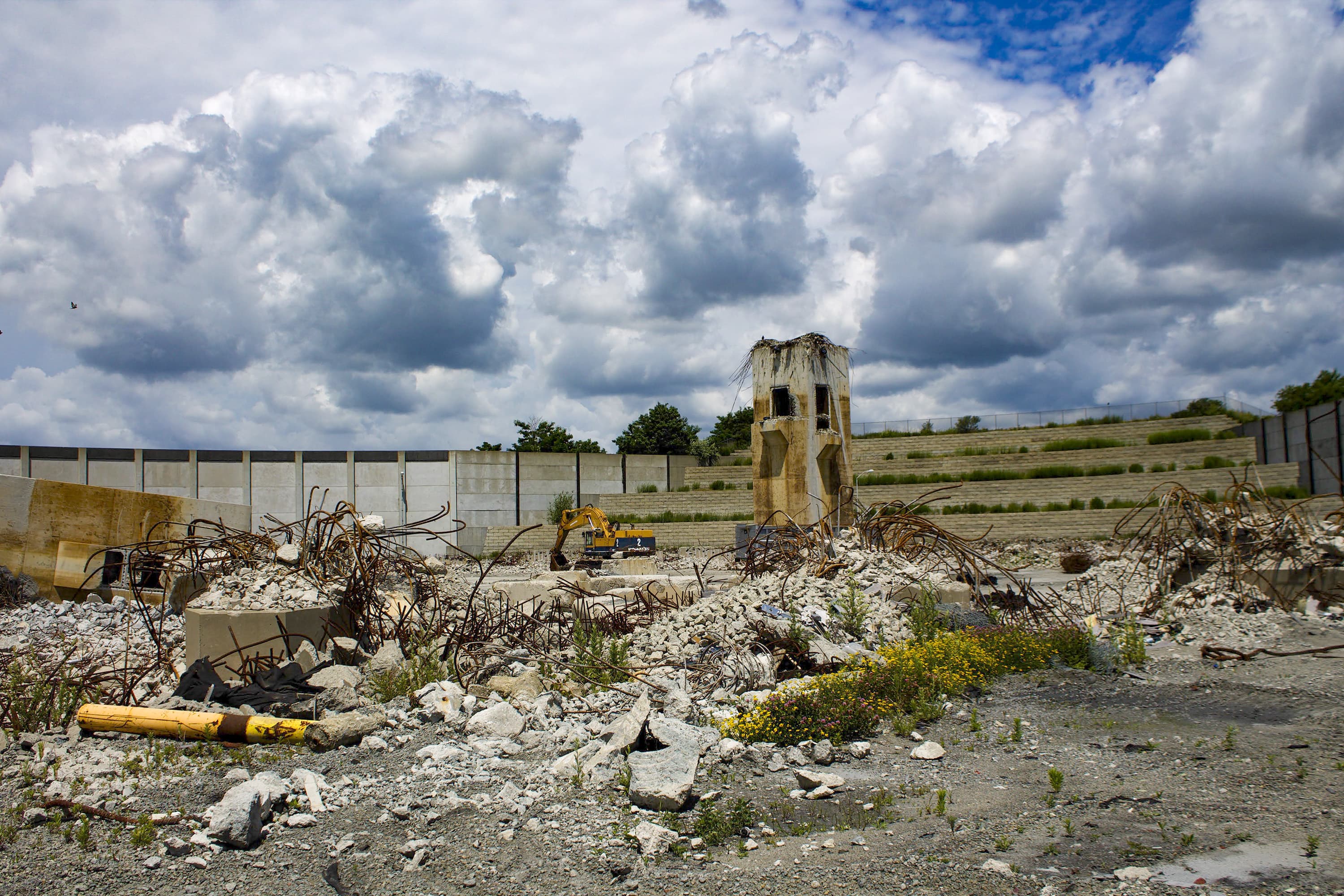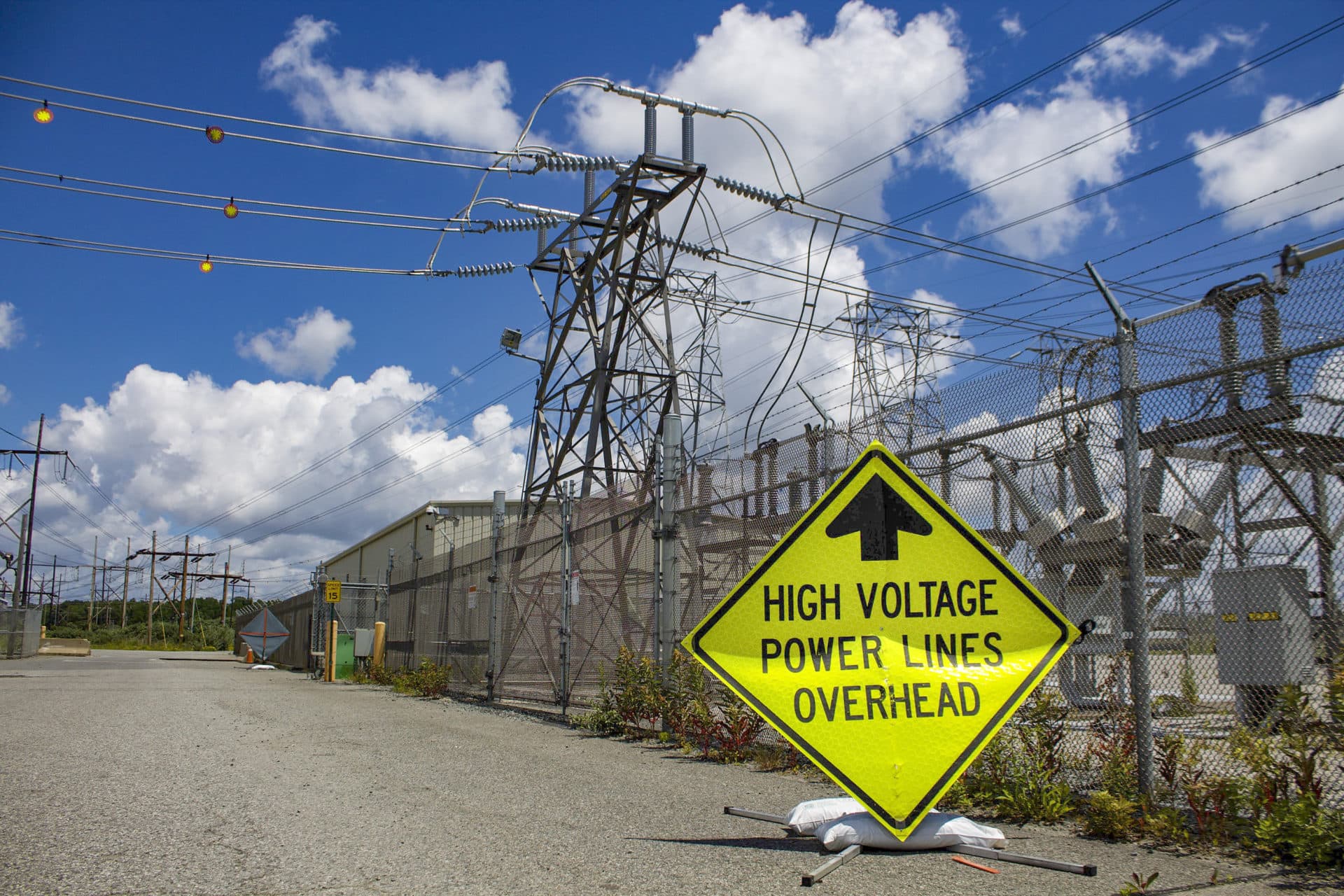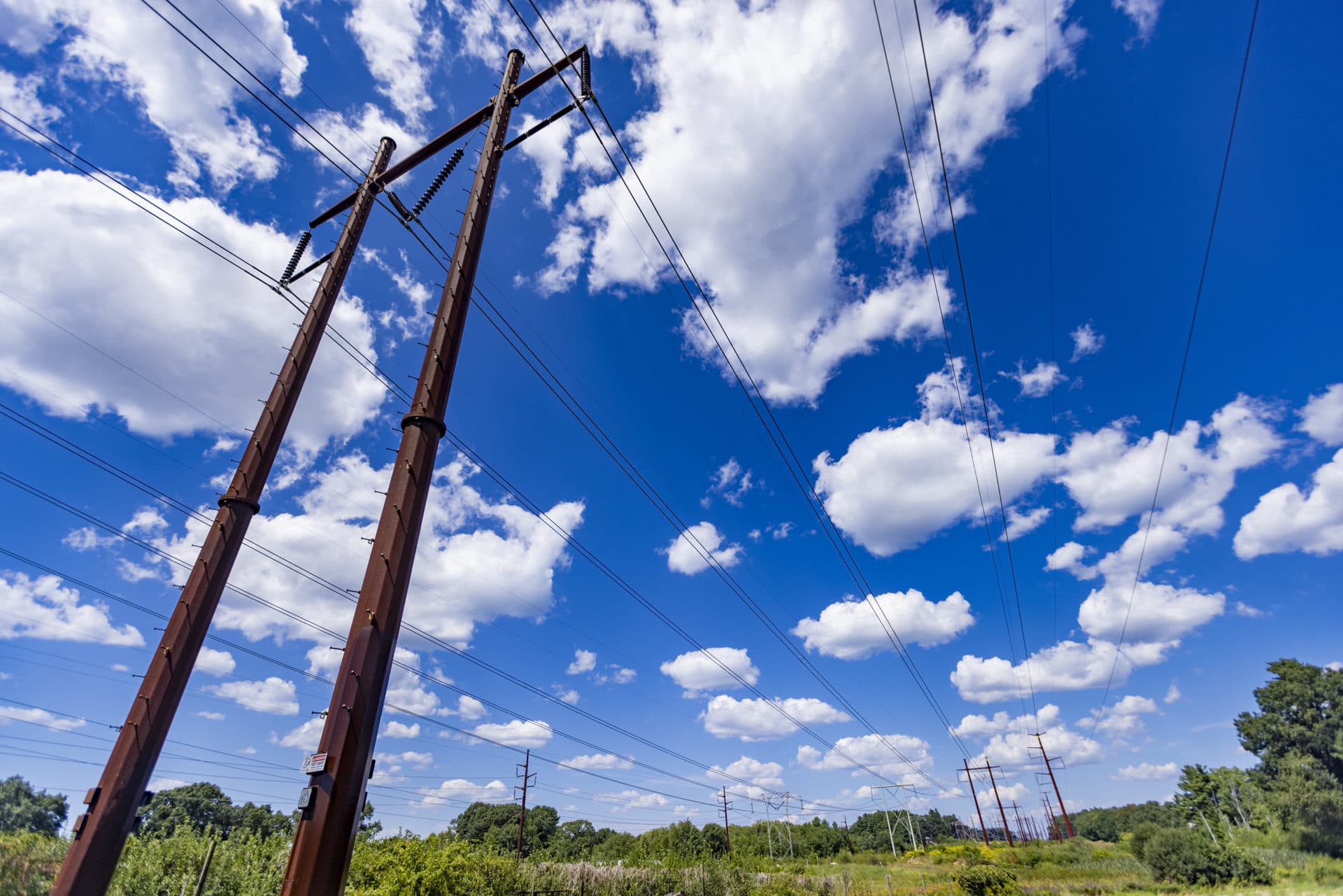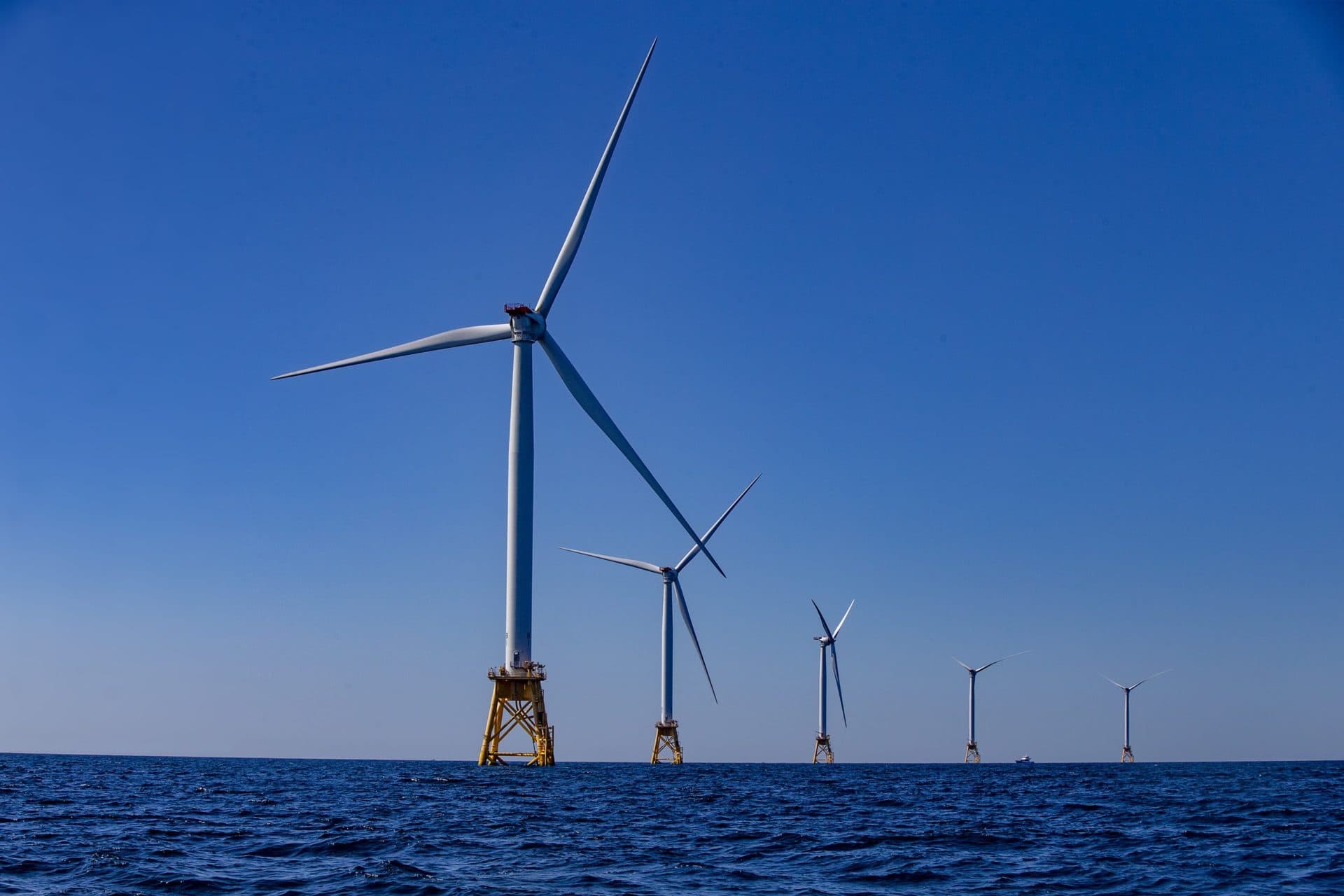Advertisement
As offshore wind plans grow, so does the need for transmission
Resume
Offshore wind has a problem: electrical transmission.
Wind developers can fairly easily run high voltage cables from their offshore projects to land, but once that power comes ashore it encounters an electrical grid that wasn’t set up to handle it.
East coast states could rebuild the onshore power grid to accommodate this power, or they could put the bulk of their effort into building an “ocean grid” — something experts say may be cheaper, faster and better for the environment.
The current approach
Lawrence Mott stands by a tall metal fence surrounding the electrical substation at Brayton Point in Somerset. Mott works for the offshore wind developer Mayflower Wind, and his specialty is the transmission system, the substations and high voltage power lines that move electricity long distances.
The humming equipment behind him, which once served as the link between New England’s largest coal-fired power plant and the grid, is about to get a new green life, he says.
It will all begin 30 miles offshore, where someday in the not-too-distant future, strong winds will spin the project’s turbines to generate electricity. Each turbine will send the power it generates to a nearby offshore platform, and from there, the electricity gets sent to shore through big cables buried six feet beneath the ocean floor.
Those cables will resurface at a beach near Brayton Point, and the electricity will eventually make its way to the substation.
“And from there, it goes into the public's grid system,” Mott says, gesturing to the big overhead power lines in the distance. “Then the electrons are out and spreading the green energy around.”
To date, all offshore wind projects in the U.S. use this design, running the equivalent of a high-voltage extension cord from wind farms to open substation near the coast. Experts say this so-called “project-by-project” approach is fine for now, but very soon, there will be two big problems.
First, we are going to run out of places like Brayton Point to plug into — in fact, almost all of the most desirable locations have already been claimed along the southern New England, New York and New Jersey coastlines.
And second, it will require really costly upgrades to the onshore transmission system.
Reversing the flow
To understand why, Eric Hines, who directs the offshore wind energy graduate program at Tufts University, says it’s helpful to picture the transmission system as a network of arteries, veins and capillaries. The arteries, or bigger power lines, can carry more electricity.
“When you plug in to the grid, you want to plug in to the arteries,” Hines says. “I mean, imagine you get a blood transfusion, you don't take it through your finger [and try to] pump blood through your capillaries.”
In the Northeast, the coastal communities closest to the offshore wind lease areas — places like Cape Cod and the eastern half of Long Island — have vein and capillary-like transmission lines. Electricity tends to flow to these areas, not from them, and they are not well-positioned to send thousands of megawatts of wind power to population centers like Boston, southwest Connecticut and New York City.
A 2021 Tufts University study that Hines helped write puts it more bluntly: “The slated offshore wind installations could easily overwhelm and congest the existing land-based grid, damaging the industry’s reputation and short-changing its growth potential.”
And that’s just accounting for the 43,000 megawatts East Coast states have already committed to procuring. Massachusetts alone expects it will need at least 15,000 megawatts by 2050 to meet its climate goals.

“With the amount of megawatts that we anticipate [from offshore wind] over the next decade, we need to be thinking in terms of optimizing how we are sending that electricity to where it's needed,” says Paula García, senior energy analyst at the Union of Concerned Scientists. “And that's one of the pieces of the equation that I think is changing the conversation right now.”
What García is describing is the growing consensus among federal and state leaders, industry experts, and environmentalists that the U.S. should build an offshore transmission grid.
Power strips for the ocean
The idea is fairly straightforward. Rather than every individual wind farm running a cable to land, they could plug into a network of high-capacity subsea power lines that come to shore in strategic places. There are many different ways this so-called “ocean grid” could be configured, but instead of “extension cords,” think of “linked power strips.”
An ocean grid wouldn’t entirely alleviate the need for onshore upgrades, but it would reduce what’s needed. It would also require putting fewer cables in the ocean, which means fewer potential environmental impacts and conflicts with fishermen. And, experts say, building it could help boost electric reliability for all coastal states.
Offshore transmission isn’t necessarily a new idea. A little over a decade ago, Google got involved in a $5 billion effort to build an “offshore backbone” to link future mid-Atlantic wind projects. At the time, the prospects for U.S. offshore wind looked promising, but as those fizzled, so too did the backbone plan.
Since then, the idea has surfaced from time to time among industry experts, but it’s really only in the last few years that the concept has started gaining traction in the U.S.
Currently, the U.S. Department of Energy and the Bureau of Ocean Energy Management are assessing various offshore transmission technologies and looking at what some northern European countries are doing. They've also held public meetings to help inform the Atlantic Offshore Wind Transmission Study report they plan to issue next year.
Work is happening at the state and regional levels too. New Jersey recently approved a transmission plan for the next few offshore wind projects it expects to procure. And New York has mandated that all offshore wind projects be “mesh ready,” meaning built with the capacity to connect to each other offshore.
Here in New England, the states are also looking to move away from the project-by-project approach and toward a planned regional “paradigm.” To this end, five out of the six states recently issued a request for information about how they can take advantage of federal dollars to plan and build some sort of offshore transmission system.
“We've really reached a tipping point where I think the benefits and the logic of shifting to an offshore grid are increasingly understood and agreed upon,” says Peter Shattuck, New England president for Anbaric, a Massachusetts-based company that specializes in building transmission for renewable energy.
With only two large offshore wind projects fully approved, and many more in various stages of planning, “we've got a natural opportunity now to focus on building out the ocean grid,” he says.
Benefits to offshore transmission
Running a few big cables from interconnected wind farms to strategic onshore locations, rather than splattering the coastline with “a spaghetti of cables,” would reduce the need for onshore transmission upgrades, says Johannes Pfeifenberger, a transmission expert at the Brattle Group.
East Coast states could theoretically build more substations and hundreds of miles of new high-voltage transmission lines on land to bring offshore wind power from the coast to big population centers further inland, but that would cost a lot of money and most likely be a legal nightmare.
That's because building new transmission infrastructure in New England is incredibly challenging. There’s not a lot of open space, and people don’t like to see new wires. The inability to build transmission lines has already delayed or killed several renewable energy projects in the region — look no further than the stalled plan to bring hydroelectric power from Quebec to Massachusetts.

Melissa Birchard, director of Clean Energy & Grid Reform at the Acadia Center, says that less onshore work also means less impact on people and communities.
“Will it still have impacts? Absolutely,” she says. "And I can imagine that there might be environmental justice communities or indigenous communities that we will need to listen to as the process moves forward. But by reducing the on-land impacts, we reduce impacts on those communities as well."
And unlike onshore transmission development, which needs approval from many regulatory bodies and individual landowners, the only “land owner,” so to speak, in the offshore wind areas is the federal government.
An ocean grid could also reduce how much cable needs to be buried beneath the ocean floor. In the current project-by-project approach, most wind developers are planning to use cables that can each carry about 400 megawatts of electricity — an 800 megawatt wind project requires two cables, for instance.
Those cables are less expensive than those that can carry 1,200 megawatts, but they lose a lot of power over longer distances. So in an ocean grid where cables need to run all the way around the Cape and up into Boston, it ends up being more efficient and cost effective to lay a few 1,200 megawatt lines to move the same amount of electricity.
To put some numbers to this, a 2020 report from the Brattle Group projected what could happen if about 12,000 megawatts of wind projects were built in the lease area near Massachusetts. A theoretical project-by-project or extension cord approach could result in 1,620 miles of subsea cables. By contrast, a planned transmission approach with higher voltage cables might only need 831 miles of line.


Laying fewer cables is good for marine ecosystems and it’s also appealing to fishermen, who worry about these lines becoming unburied and getting caught in trawl lines.
An ocean grid — especially one that’s designed with fishermen input — could “reduce the potential for conflict between commercial fishing and the offshore energy sector,” Lane Johnston, programs manager of the Responsible Offshore Development Alliance, a group representing commercial fishermen, writes in an email.
Another potential benefit to building a coordinated offshore transmission system is increased electric reliability. If wind farms are connected offshore, the failure of one cable doesn’t necessarily prevent a project’s electricity from getting to land. And, experts say, if someday in the future, there’s an offshore grid extending along the East Coast, power from New England could theoretically flow to the mid-Atlantic states, or vice versa, should demand suddenly spike in one region.
“A connected offshore transmission system can actually reinforce the onshore grid,” Pfeifenberger says.
A lot to be determined
If this whole concept feels a bit abstract, that’s because it is. At least for now.
An offshore transmission system could take multiple forms. It could be a central “backbone” that runs from Maine to Florida, or different states could pursue transmission projects simultaneously and then choose to connect them in the future. The entire thing could be planned and built by a third party like Anbaric, which has proposed offshore transmission projects for New Jersey and southern New England. Or states could dictate where wind developers need to connect their cables to land and offshore.
What’s important, though, is that plans are flexible and the technology is compatible, says Hines, because cable and interconnection technology is rapidly evolving.
“You want to have a plan, and you want to be in a position where you can update the plan,” he says. “For instance, it doesn't make any sense to have a whole bunch of developers use a whole bunch of different cable technologies that would be really expensive to connect together.”

And then, of course, there are the big questions: Who is going to pay for all of this? Who will build it? Who will own it? What should it even look like? How can wind developers — who are on the line to deliver a lot of power by specific dates — be assured this system will be constructed on time if it's turned over to a third party?
No one said that building offshore transmission would be easy. But when you compare it to the alternative of only land-based upgrades, many experts say it starts to look pretty good.
“I’m optimistic that we can do this,” says Birchard. “But we need to do it right and we need to do it now” because we need more renewable energy powering the grid as soon as possible.
Editor's note: After this story was published, the New Jersey Board of Public Utilities approved a new transmission plan for the state's next few offshore wind projects. This article has been updated to reflect that change.
This segment aired on October 18, 2022.
